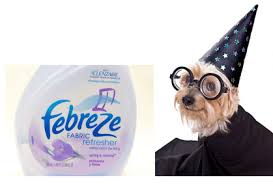Can the Swiffer WetJet poison dogs? According to an Internet rumour that started circulating in early 2004, it can. The following landed in this author’s inbox in September 2004 …
I recently had a neighbor who had to have their 5-year old German Shepherd dog put down due to liver failure. The dog was completely healthy until a few weeks ago, so they had a necropsy done to see what the cause was. The liver levels were unbelievable, as if the dog had ingested poison of some kind. The dog is kept inside, and when he’s outside, someone’s with him, so the idea of him getting into something unknown was hard to believe. My neighbor started going through all the items in the house. When he got to the Swiffer Wetjet, he noticed, in very tiny print, a warning which stated “may be harmful to small children and animals.” He called the company to ask what the contents of the cleaning agent are and was astounded to find out that antifreeze is one of the ingredients. (actually he was told it’s a compound which is one molecule away from antifreeze).
Therefore, just by the dog walking on the floor cleaned with the solution, then licking it’s own paws, and the dog eating from its dishes which were kept on the kitchen floor cleaned with this product, it ingested enough of the solution to destroy its liver.
Soon after his dog’s death, his housekeepers’ two cats also died of liver failure. They both used the Swiffer WetJet for quick cleanups on their floors. Necropsies weren’t done on the cats, so they couldn’t file a lawsuit, but he asked that we spread the word to as many people as possible so they don’t lose their animals.
The “Swiffer WetJet poisoning pets” story is an urban legend. It was, and still is being spread to every corner of the world via the connecting web of the Internet. When closely examined, it exudes falsehoods typical of the best legends. Most obvious is the fact that the source is anonymous – details cannot be verified.
The story suggests that the active cleaning agent in the Swiffer WetJet is one molecule away from the toxic antifreeze. This is incorrect. The ingredients in Swiffer are, in fact, closer to food additives in nature, and are the same compounds used in a wide array of cleaning solutions.
The legend creator even got the medical facts wrong – antifreeze causes kidney damage, not liver failure. The warning quoted from the label is also incorrect. The actual wording is “Avoid Accidents: Keep out of reach of children and pets.”
The manufacturer of the Swiffer, Proctor and Gamble (P&G), responded to the legend by stating that its product leaves no residue on floors. They got the ASPCA Poison Control Center to review the Swiffer and deem it safe.
 Another P&G product – Febreze – fell victim to a similar legend. Stories suggested that multiple dogs and birds died or became ill after being exposed to Febreze. If deaths did indeed occur, were they coincidental, meaning the dogs died at the same time the owner used Febreze, or did they die because of the Febreze? Again, the ASPCA tells us that Febreze can be safely used around cats and dogs.
Another P&G product – Febreze – fell victim to a similar legend. Stories suggested that multiple dogs and birds died or became ill after being exposed to Febreze. If deaths did indeed occur, were they coincidental, meaning the dogs died at the same time the owner used Febreze, or did they die because of the Febreze? Again, the ASPCA tells us that Febreze can be safely used around cats and dogs.
Some urban legends are grounded in truth. In 2005, a rumour circulated that a disease called the canine flu was being passed to dogs through infected horse meat. Though a new viral disease, called the canine flu, had surfaced in racing Greyhounds, it was identified as a mutation of a horse flu virus. It did not come from horse meat.
The flu legend depicted images of epidemics spreading through dogs at racetracks. It described show dogs, valued at $100,000 each, dying while packed in ice and hooked up to IV lines. Although it is true that some dogs have died from the canine flu, studies suggest the mortality (death) rate is low, only about one percent. And, how many show dogs are really worth $100,000?
 Another truth-based story reveals the toxic potential of grapes and raisins which contain an unknown ingredient that causes kidney failure in dogs. The legend suggests you should panic if your dog eats one or two grapes. This is an exaggeration. Your dog can handle a couple; just don’t feed him a bunch.
Another truth-based story reveals the toxic potential of grapes and raisins which contain an unknown ingredient that causes kidney failure in dogs. The legend suggests you should panic if your dog eats one or two grapes. This is an exaggeration. Your dog can handle a couple; just don’t feed him a bunch.
Some legends are completely unbelievable yet they continue to circulate. Take the woman who came home to find her Doberman gagging on the floor. She rushed him to her veterinarian who examined the dog and said he would do a tracheotomy “later”.
The owner arrived home to a ringing phone. It was her veterinarian – he told her to get out of the house and immediately call the police. He had found three dismembered fingers stuck in the dog’s throat. Police later found an unconscious intruder in a closet. Again, the legend is anonymous. Do you really think a veterinarian would delay surgery if a dog was choking on his exam table? And why would the dog choke? Wouldn’t he just swallow the fingers?
How about the eagle that made off with a prized pooch? At an Alaskan gas station, a couple let their poodle out of their motorhome so he could get some exercise. A hungry eagle swooped down and took the dog away. While the woman broke into tears, her husband (supposedly) went behind the motorhome to cheer.
There are many variations on this legend – different breeds of dogs taken by eagles, a Chihuahua eaten by a pelican, and a poor dog gulped by a shark. Yes, an eagle can take a small dog, but this story is obviously embellished to entertain readers. And, the husband is a consistent part of each story.
Another story well circulated describes a seeing eye dog that reportedly caused the death of four of his owners. This dog, called Lucky, led his first blind owner in front of a bus, the second off a pier, the third in front of a train, and the fourth into heavy traffic. However, besides having the occasional epileptic fit, he was deemed to be a good dog.
Lucky’s fifth owner was not told of his record. After all, knowing about the previous accidents would make the person nervous. Lucky would then get anxious and he would be more likely to make a mistake. Think about it – no organization would put an epileptic dog into service nor would they rehome one with such a record.
Urban legends are kept alive because people who believe them, as well as those who have enough common sense to recognize them for what they are, continue to pass them on.
If you receive a message in your inbox, and you can’t determine its validity, you can get some help through the Internet. The web sites listed below investigate the truth (or lack of truth) in urban legends. It is up to you whether you perpetuate the story or whether you send it promptly to your trash can.
Sources for tracking urban legends include:
Dr. Louise Janes D.V.M. & Dr. Jeff Grognet D.V.M.
 Mid-Isle Veterinary Hospital
Mid-Isle Veterinary Hospital
5-161 Fern Road West
Qualicum Beach, BC
Tel (250) 752-8969
See all articles by Dr. Louise Janes D.V.M. & Dr. Jeff Grognet D.V.M.



